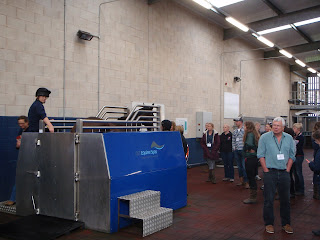The 2nd of November saw
us host our first Alternative Therapies Evening in association with the British
Horse Society and Town and Country Vets.
I was very lucky to have my own
horse used in the physiotherapy demonstration with Anne Skivington (a
Veterinary Physiotherapist) and found the whole session exceptionally
educational! Anne discussed the process she goes through when assessing horses
as well as a demonstration of some of the equipment she uses including the
H-wave machine and therapeutic ultrasound.
John Abbott and Sandy Briar of Town
and Country Vets gave us a detailed insight into the horse’s anatomy through
dissection of the distal limb, spine and sacroiliac joint. It was amazing to be
able to get up close and get a better understanding of horses on the inside,
although somewhat stomach turning! For me, being able to actually see thoracic
vertebrae and their proximity to each other certainly aided my understanding of
kissing spines.
Sammy Rose,
also of Town and Country Vets, gave a very interesting demonstration on the use
of acupuncture. Out trusty College
Horses, Portia and Scooby, certainly seemed to find the session relaxing and
Sammy provided a real insight into the benefits of acupuncture for all types of
horses.
The final session of the evening
was a demonstration in the therapy centre by Jessica York (Hydrotherapist) and me! Our demo horse, Bailey showed spectators what
a fantastic exercise tool the aqua-treadmill is and we were so pleased with his
super star coolness given the number of spectators. Both Jessica and I fielded questions on the
benefits of the treadmill and were able to show the crowd the impact that the
treadmill can have on a horse’s way of going by running through the different
settings while Bailey politely obliged.
Overall the evening was a great
success with lots of interesting questions and discussion. The feedback we received from everyone that
attended was very positive and it turns out everybody really enjoyed themselves
and learned a lot from the different sessions.
All of the funds from the ticket
sales went to the British Horse Society in support of their welfare and
educational work and we are very supportive of the newly resurrected Northamptonshire
BHS Committee.
Thank you so much to everybody that
came out on a chilly November evening and of course thank you to Town and
Country Vets and Anne Skivington for their fascinating demonstrations. We intend to host another educational evening
in the Spring and being that bit warmer we hope to also be able to demonstrate
some swimming sessions as well. Watch
this space!
Written By: Molly Baxter – Moulton
College Equestrian Rehabilitation Groom








